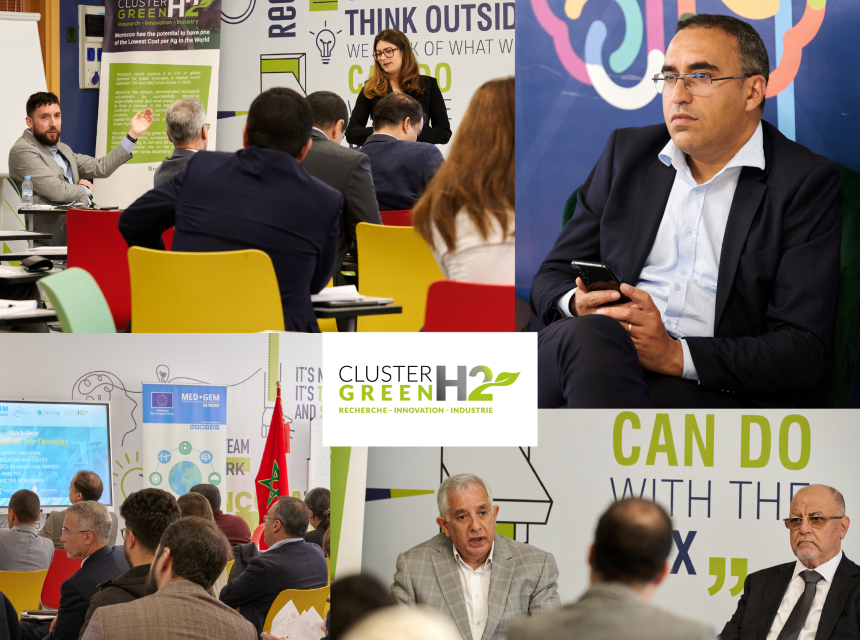Cluster Green H2: Morocco’s Road to Europe
Cluster Green H2: Morocco’s Road to Europe
Interview with Mourad Hajjaji, Director General, Cluster Green H2 – Morocco
Published in Spotify > Listen to the Podcast (French)
As the global race toward clean energy accelerates, Morocco is positioning itself as a frontrunner in the green hydrogen economy. On 23–24 April 2025, a Training of Trainers Workshop was held in Rabat under the MED-GEM Network, funded by the European Union and in partnership with the Cluster Green H2, HINICIO and CertifHy. The two-day session focused on the certification of renewable fuels of non-biological origin (RFNBOs), aligned with the EU Renewable Energy Directive.
On this occasion, we spoke with Mr Mourad Hajjaji, Director General of the Cluster Green H2 – Morocco, about Morocco’s strategic ambition and how regional cooperation can foster a greener, more integrated Mediterranean future.
A Vision for the Region
“Morocco took the hydrogen challenge seriously in 2021,” Mr Hajjaji explains. “We quickly saw the potential to shift from being an energy importer to a reliable exporter of green molecules — powered by competitive solar and wind energy.”
Europe’s demand for renewable hydrogen far exceeds its domestic production capacity. With just a few hundred kilometres between North Africa and European markets, Morocco and its neighbours are geographically and economically well-placed to respond.
Building the Ecosystem: The Role of the Cluster
Hydrogen is not a product — it is a value chain. The Green H2 Cluster, launched in 2021, was designed to structure this complex ecosystem: from renewable developers and desalination operators to transporters, industrial integrators and research institutions.
“Our role is to coordinate actors, facilitate dialogue with donors and networks like MED-GEM, and make policy recommendations to the Moroccan government — especially on certification and regulatory alignment with the EU,” says Hajjaji.
Preparing for EU Standards
Meeting European standards, including those under the RED II and RED III Directives, is essential for market access. Morocco is no stranger to these requirements — similar compliance is already part of its agriculture and fisheries sectors. Still, hydrogen certification presents new challenges.
“This workshop is our fourth in partnership with MED-GEM. We are training over 50 Moroccan stakeholders — future exporters, developers and regulators — to align with EU standards.”
The work includes preparing regulatory frameworks, strengthening local capacity, and clarifying how certification — particularly the mass balancing approach — will be implemented nationally.
Regional Cooperation is Not Optional
Asked about cooperation with neighbours, Mr Hajjaji is unequivocal: “It’s essential.”
Through MED-GEM, countries like Morocco, Egypt, Tunisia and Mauritania can align certification systems, share knowledge and build negotiating power vis-à-vis the European Union. For example, challenges such as access to biogenic carbon for synthetic fuels could be overcome through regional sourcing or collective dialogue with Brussels.
MED-GEM has also delivered valuable studies — on workforce readiness and industrial integration — which Morocco is using to engage vocational training institutions, universities and industrial clusters. “You can’t wait for investors to arrive. We must build capacity now — so that skilled technicians and engineers are ready when large-scale hydrogen projects go online.”
What’s Next?
Morocco’s export strategy will likely begin with green ammonia, thanks to strong domestic demand from OCP Group, the national phosphate company. Other vectors — such as methanol for shipping or e-kerosene for aviation — will follow as EU regulations tighten.
With ultra-competitive renewables in the south, and ports like the new Dakhla Atlantic and Nador West Med under development, Morocco is shaping up to be one of the world’s most competitive hydrogen hubs.
“We see MED-GEM as a catalyst,” concludes Mr Hajjaji. “It gives us a roadmap and a community — and helps ensure that the green hydrogen transition is not only fast, but fair, traceable, and regionally rooted.”

